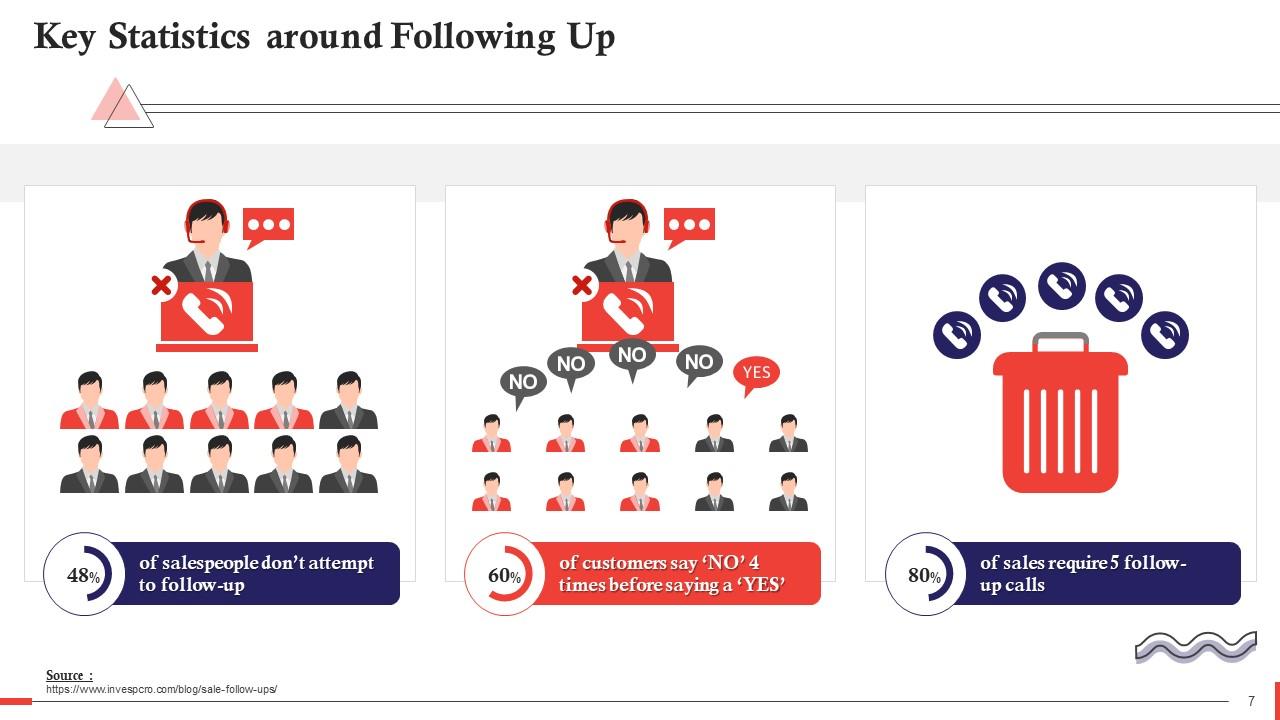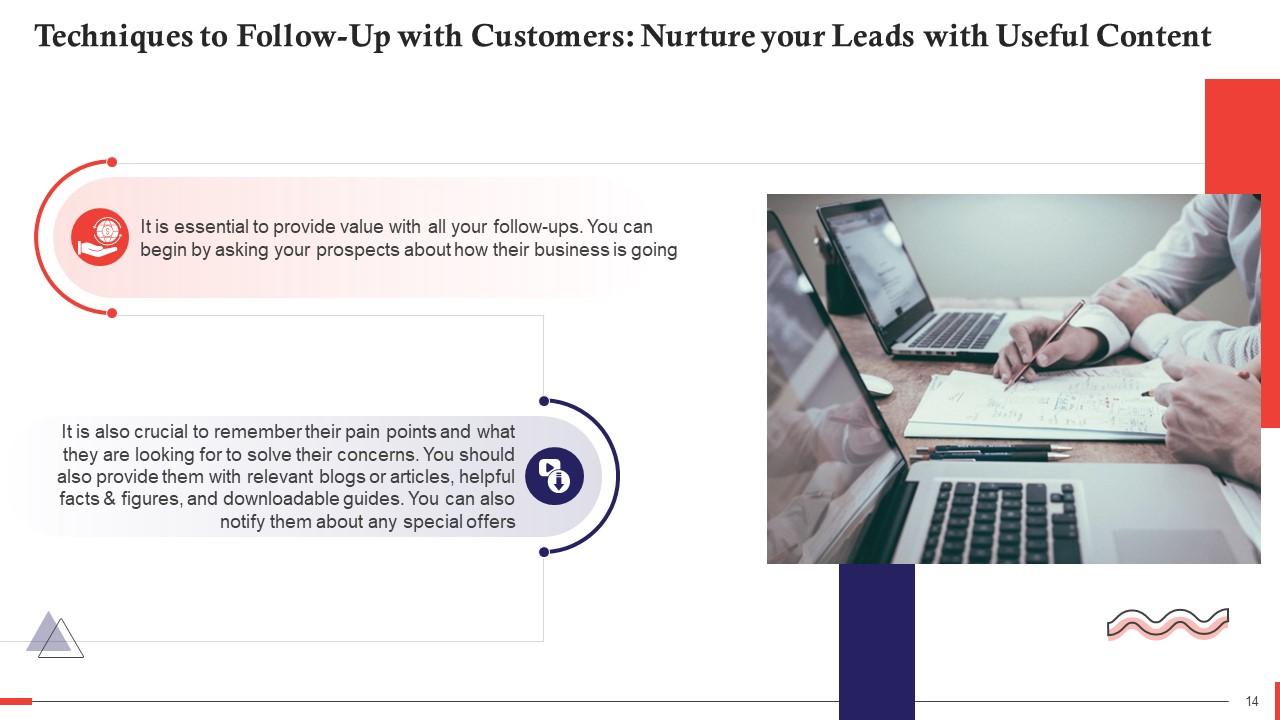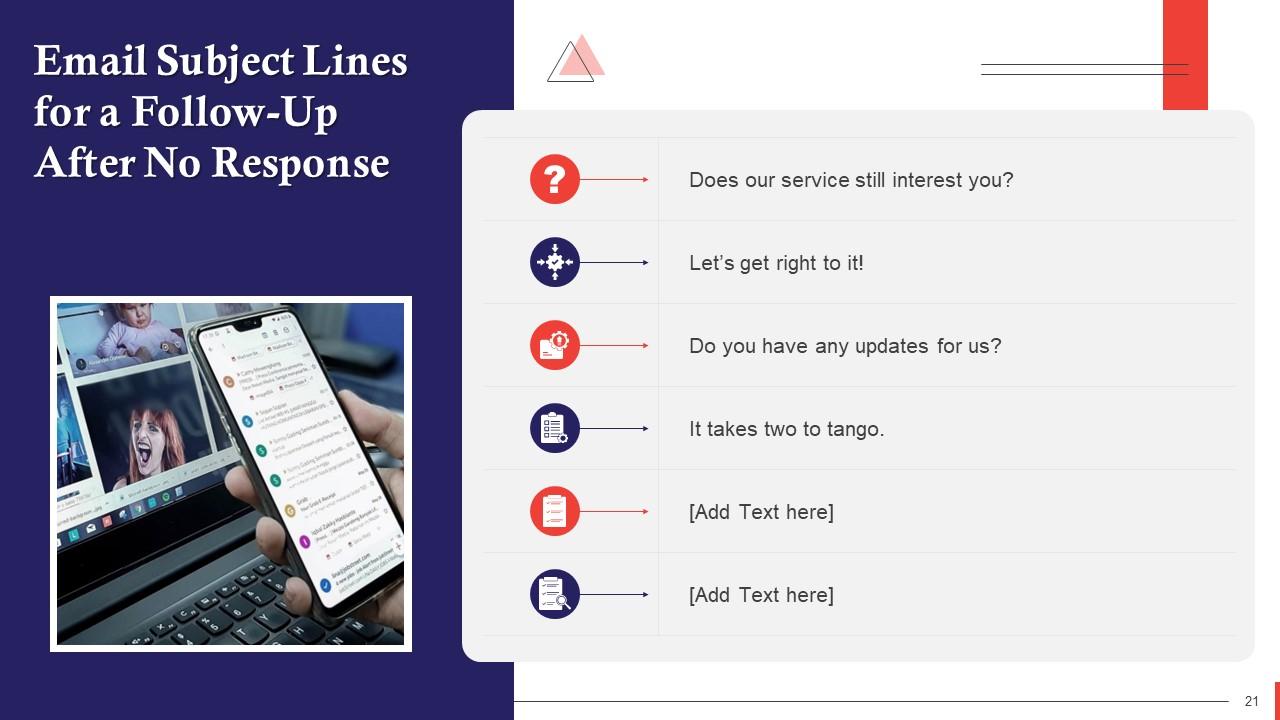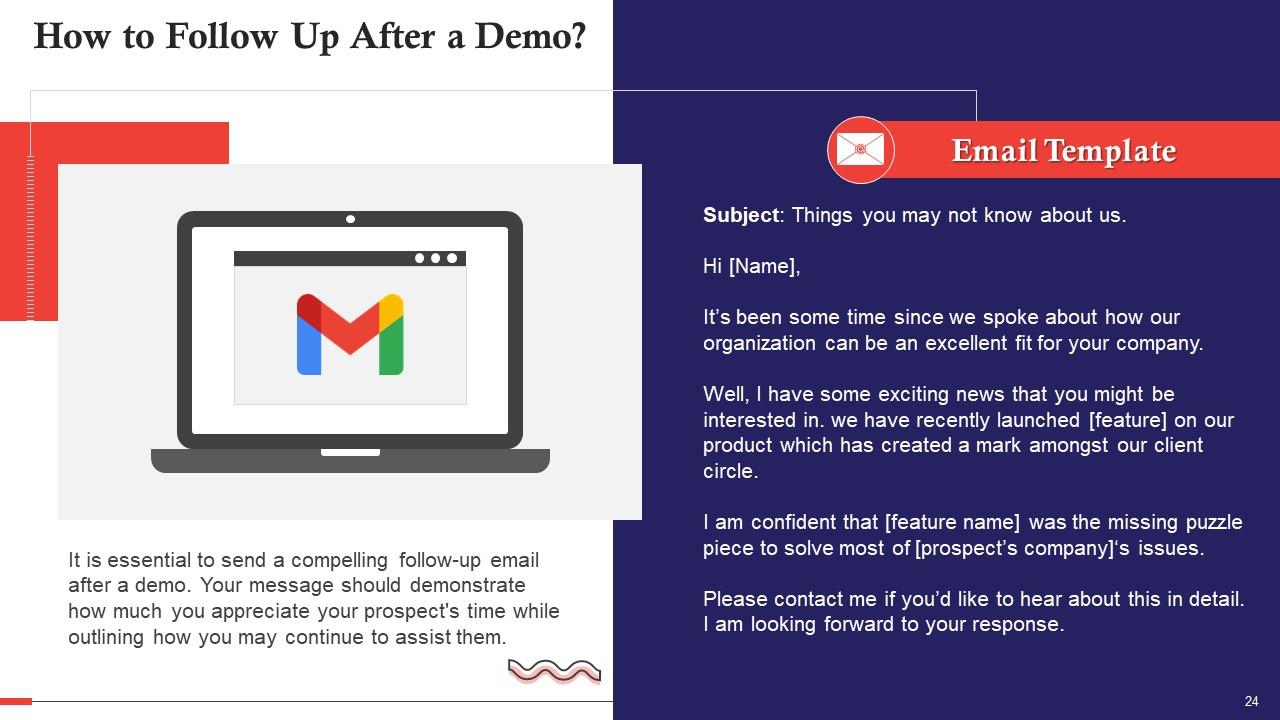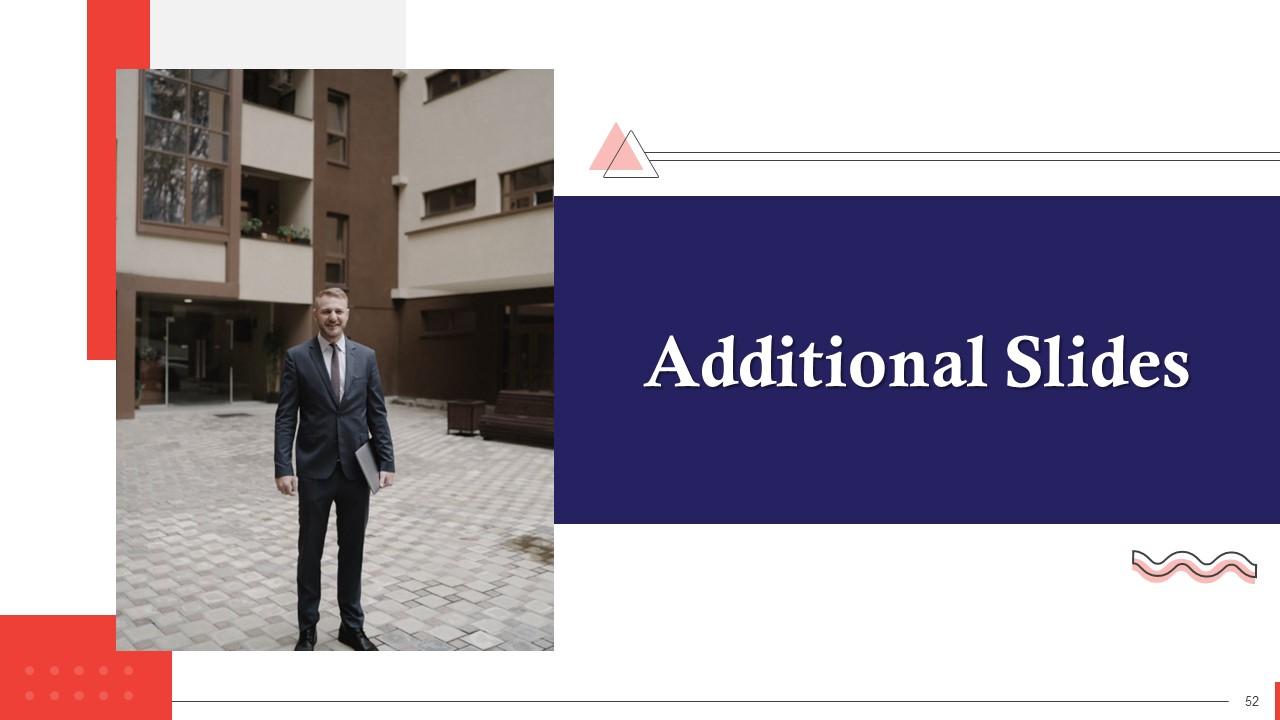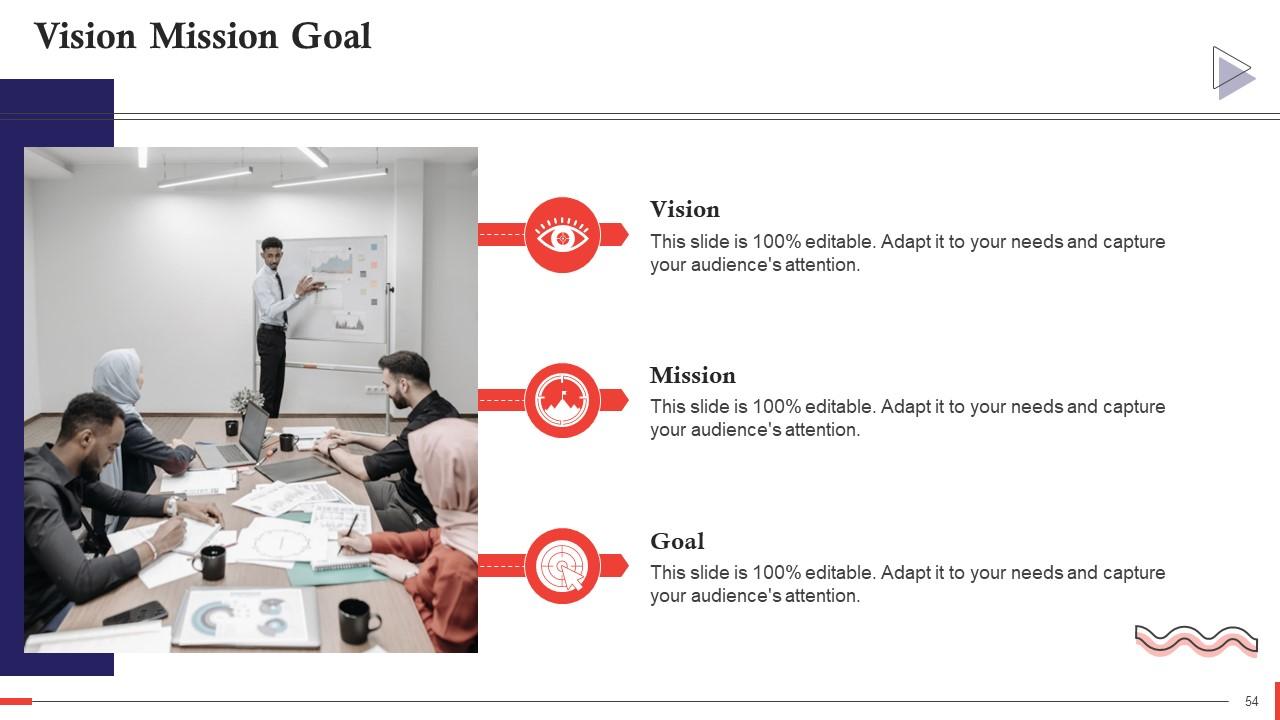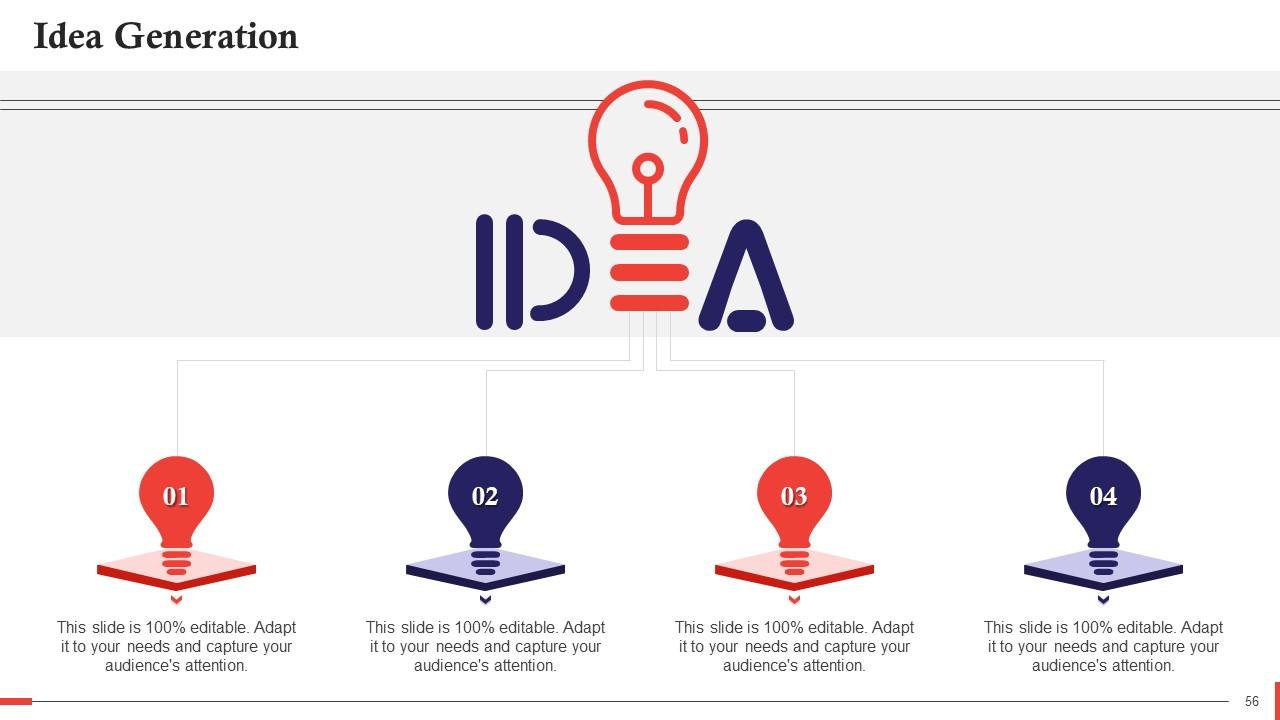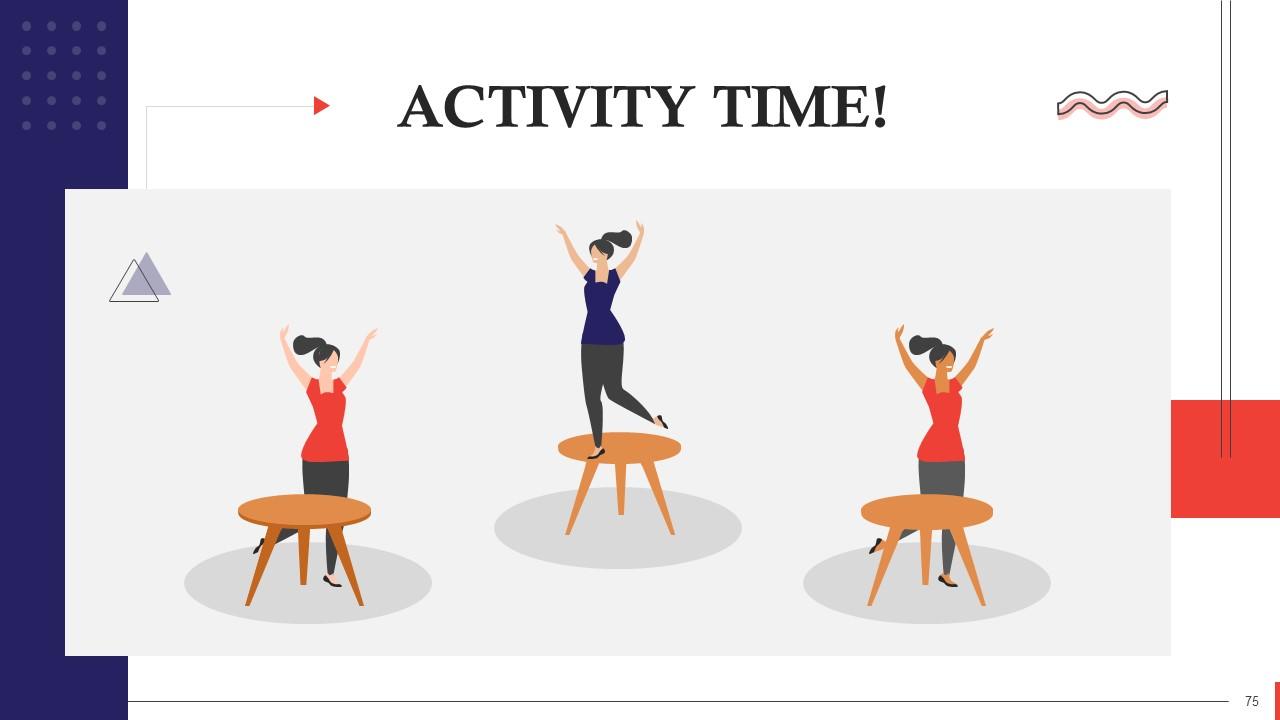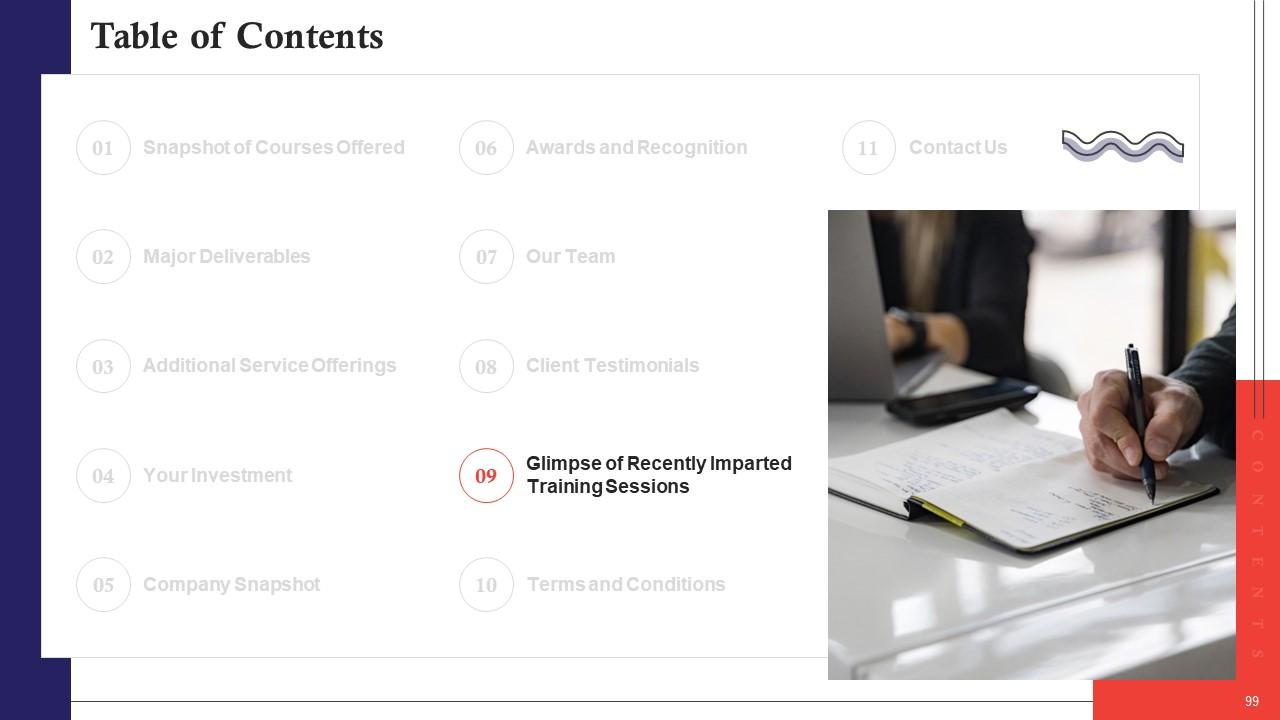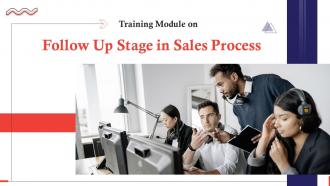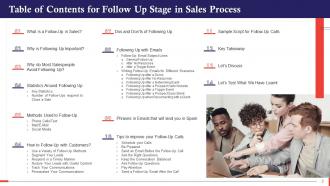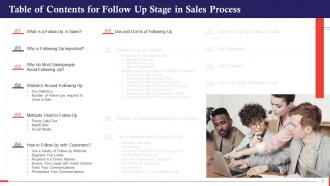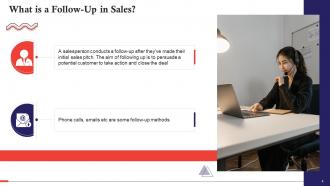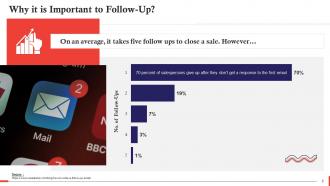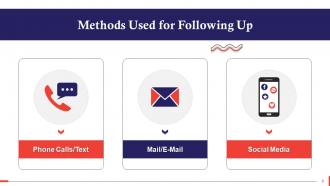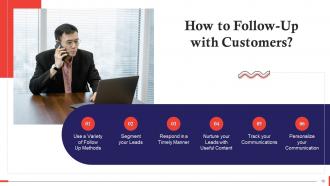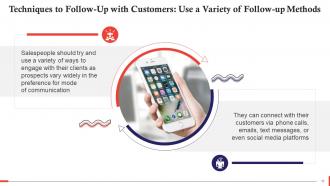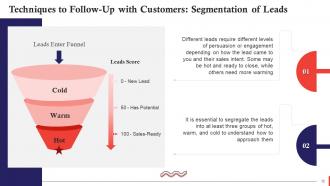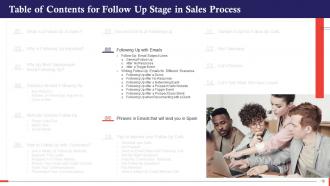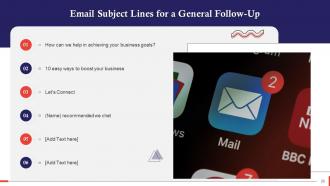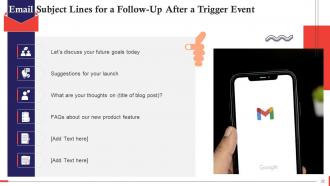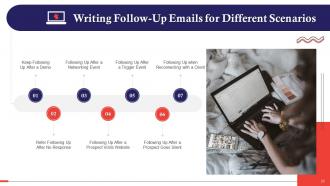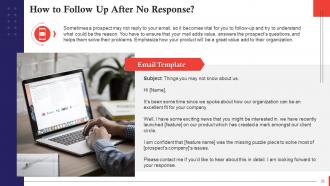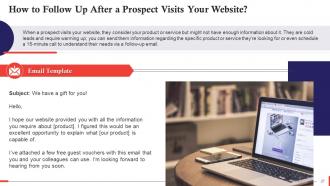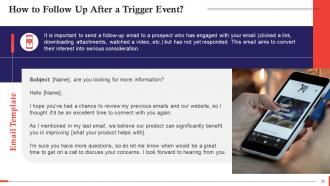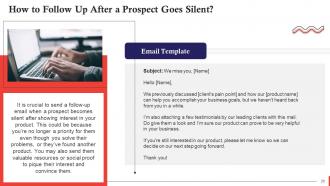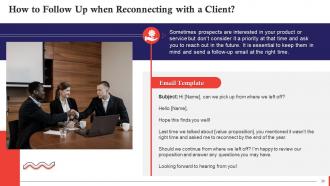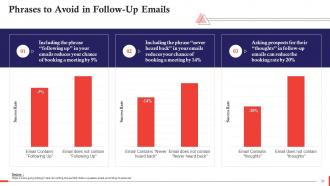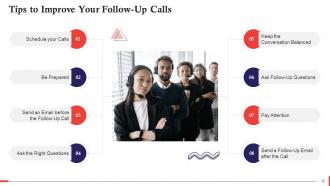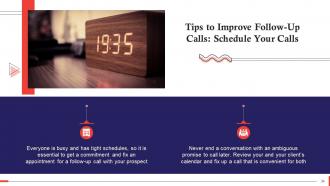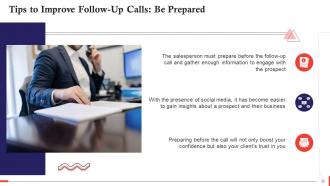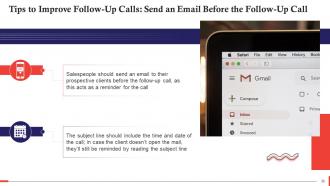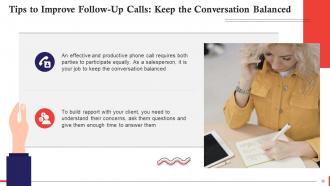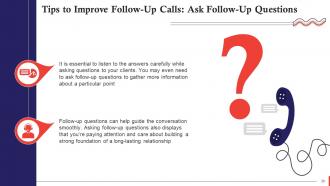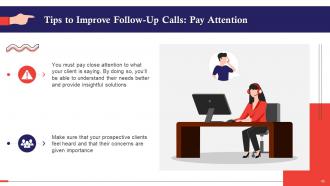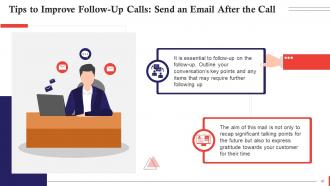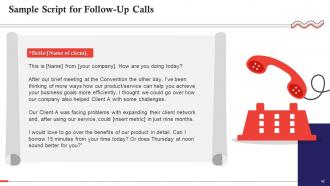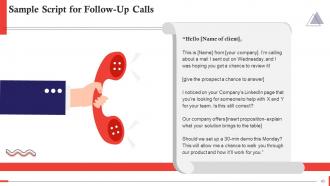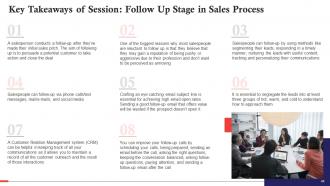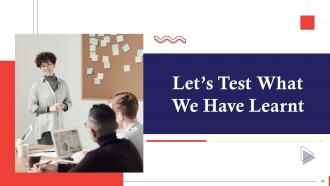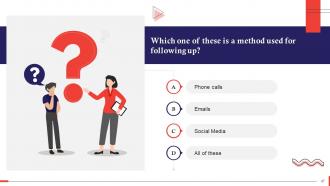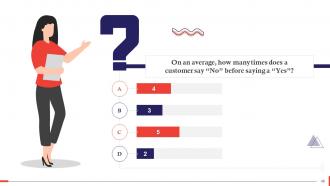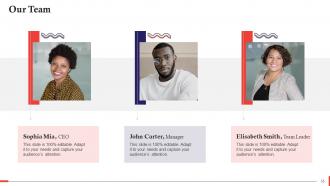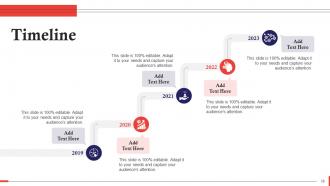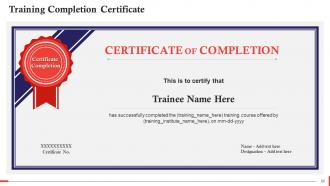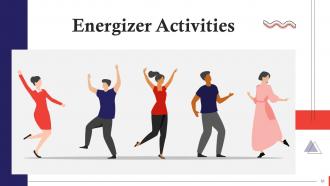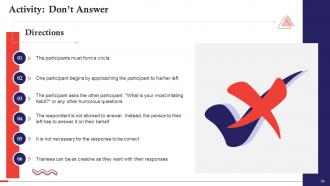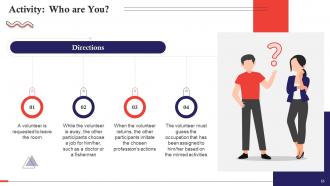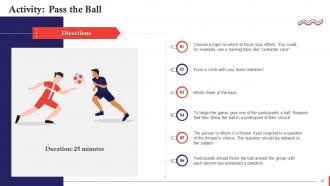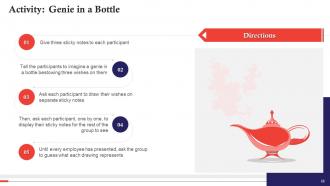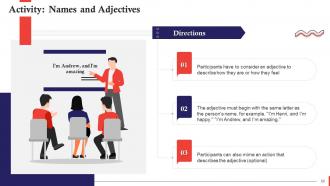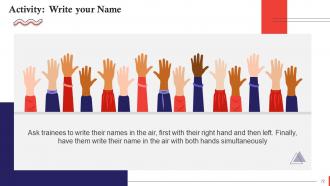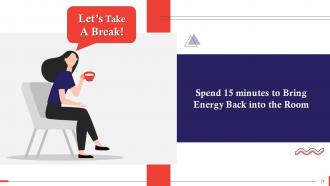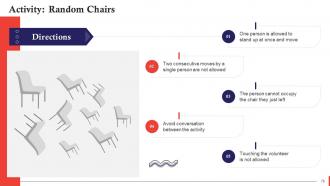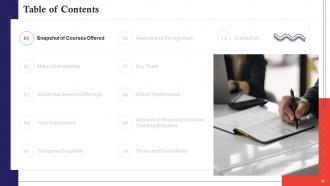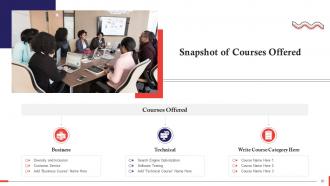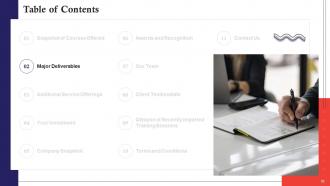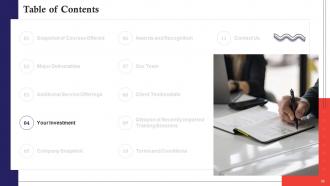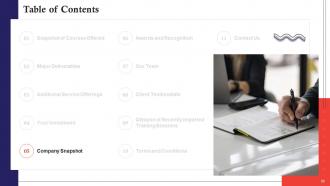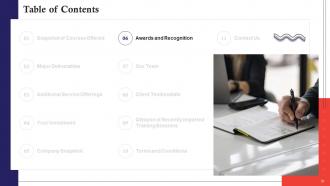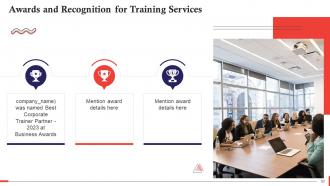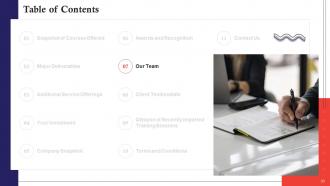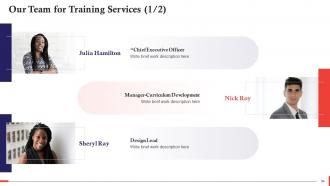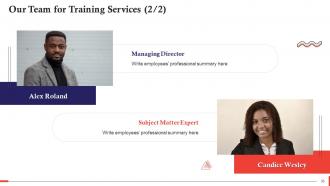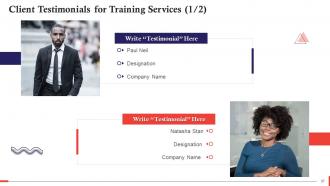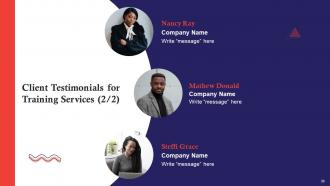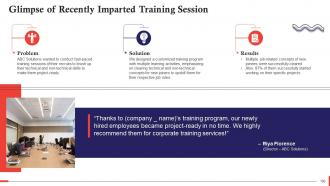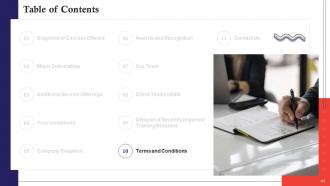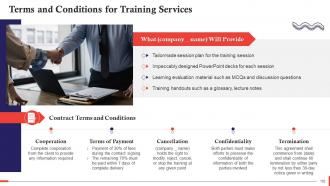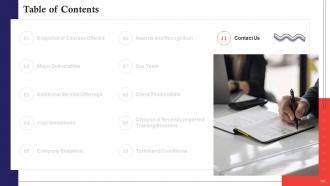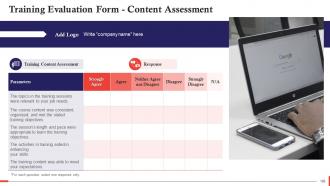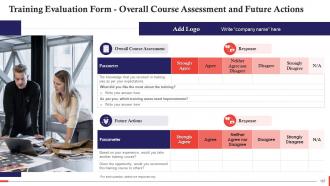Follow Up Stage In Sales Process Training Ppt
This training module on Follow Up Stage in Sales Process covers the concept of Follow-Up in Sales, its importance, and Why Most Salespeople Avoid Following Up. Then it discusses the Methods Used to Follow-Up Phone Calls or Text, Mail or E-Mail, Social Media, How to Follow-Up with Customers. Use a Variety of Follow-Up Methods, Segment Your Leads, Respond on Time, Nurture Your Leads with Useful Content, Track Your Communications, Personalize Your Communications, and Dos and Donts of Following Up. Further, comprehensively it covers Following Up with Emails, Phrases in Emails that will Land you in Spam, and Tips to Improve your Follow-Up Calls Schedule your Calls, Be Prepared, Send an Email Before the Follow-Up Call, Ask the Right Questions, Keep the Conversation Balanced, Ask Follow-Up Questions, Pay Attention, Send a Follow-Up Email After the Call. It also includes Key Takeaways and Discussion Questions related to the topic to make the coaching session more interactive. The deck has PPT slides on About Us, Vision, Mission, Goal, 30-60-90 Days Plan, Timeline, Roadmap, Training Completion Certificate, and Energizer Activities. It also includes a Client Proposal and Assessment Form for training evaluation.
You must be logged in to download this presentation.
 Impress your
Impress your audience
Editable
of Time
PowerPoint presentation slides
Presenting Training Deck on Follow Up Stage in Sales Process. This deck comprises of 107 slides. Each slide is well crafted and designed by our PowerPoint experts. This PPT presentation is thoroughly researched by the experts, and every slide consists of appropriate content. All slides are customizable. You can add or delete the content as per your need. Not just this, you can also make the required changes in the charts and graphs. Download this professionally designed business presentation, add your content and present it with confidence.
People who downloaded this PowerPoint presentation also viewed the following :
Content of this Powerpoint Presentation
Slide 4
This slide introduces the concept of following up in sales. A salesperson conducts a follow-up after they’ve made their initial sales pitch. The aim of following up is to persuade a potential customer to take action and close the deal.
Slide 5
This slide highlights the importance of following up in sales. Following up is essential to generate positive results and get the most out of your sales process. A salesperson better understand their customers’ needs while following up, which is essential for a successful deal.
Slide 6
This slide lists reasons why salespeople are reluctant to follow up. One of the biggest reasons is that they believe that they may build a reputation of being pushy or aggressive due to their profession and don’t want to be perceived as annoying.
Slide 7
This slide highlights some key statistics around following up in sales. About 48 percent of salespeople don’t attempt to follow-up, 60 percent of customers say ‘no’ four times before saying a ‘yes’, and 80 percent of sales require five follow-up calls.
Slide 8
This slide depicts the importance of following up in sales. It takes five follow up calls to close a sale. However, 70 percent of salespeople give up after they don’t receive a response to their first email and only 1 percent of salespeople go through with five follow-ups.
Slide 9
This slide showcases methods that can be used for sales follow-up. Salespeople can follow-up via phone calls/text messages, mail/e-mails, and social media.
Instructor’s Notes:
- Phone Calls/ Texts: Phone calls are considered to be the easiest and most effective way of following up as they are personal and a great way to obtain feedback from customers
- Mail/E-Mail: Following up via mail or e-mails can be personalized according to the customer. However, hearing back from them is difficult since most of the people choose no to respond to them
- Social Media: You can ask customers to engage with you over social media. You can also encourage them to write reviews or complete surveys on social media sites
Slide 10
This slide highlights some techniques for following up with customers. Salespeople can follow-up by using methods like segmenting their leads, responding in a timely manner, nurturing the leads with useful content, tracking and personalizing their communication
Slide 11
This slide talks about the importance of using various methods for following up with customers. Salespeople should try and use a variety of ways to engage with their clients as prospects vary widely in the preference for mode of communication.
Slide 12
This slide talks about the importance of segmentation of leads for following up with them. Different leads require different levels of persuasion or engagement depending on how the lead came to you and their sales intent. Some may be hot and ready to close, while others need more warming.
Slide 13
This slide discusses responding to leads in a timely manner while following up with customers. It is essential to respond to your leads with a thank you mail or call within 12 - 24 hours of their coming in.
Slide 14
This slide talks about the importance of nurturing your leads while following up with them. It is essential to provide value with all your follow-ups. You should also provide them with relevant blogs or articles, helpful facts & figures, and downloadable guides. You can also notify them about any special offers.
Slide 15
This slide talks about the importance of tracking your communications while following up with customers. You need to maintain a record of all your communications as it offers you insights that can help you improve your following up process.
Slide 16
This slide talks about the importance of using personalization as a way of following up with customers. Personalization can go a long way while following up with leads. You can customize your correspondence by including the recipient’s name in emails and sending them information that is relevant to them.
Slide 17
This slide highlights dos and don’ts of following up. A salesperson should respond quickly, maintain different mailing lists for different leads based on their buying intent, provide value, and have a friendly attitude while following up. They should not overwhelm their leads, make them feel guilty for not responding, and be ambiguous with their message.
Slide 19
This slide discusses the importance of crafting a good email subject line while sending a follow-up email. This is essential for achieving high email open rates. Sending a good follow-up email that offers value will be wasted if the prospect doesn’t open it.
Slide 20
This slide gives examples of email subject lines for a general follow-up.
Slide 21
This slide gives examples of email subject lines for a follow-up after no response from a client.
Slide 22
This slide gives examples of email subject lines for a follow-up after a trigger event such as a link click etc.
Slide 23
This slide highlights scenarios for writing follow-up emails. These are following up after a demo, no response, a networking event, a prospect visiting your website, a trigger event, a prospect going silent, and reconnecting with a client.
Slide 24
This slide depicts how to write a follow-up email after a demo. It is essential to send a compelling follow-up email after a demo. Your message should demonstrate how much you appreciate your prospect's time while outlining how you may continue to assist them.
Slide 25
This slide depicts how to write a follow-up email after no response. Sometimes a prospect may not reply to your email, so it becomes vital for you to follow-up and try to understand what could be the reason. You have to ensure that your mail adds value, answers the prospect’s questions, and helps them solve their business problems.
Slide 26
This slide depicts how to write a follow-up email after a networking event. Networking events or conferences are good places to form new connections and find out people who’d be interested in your product or service. Hence, it becomes important to follow-up with these people after the event to take the sale to the next step.
Slide 27
This slide depicts how to write a follow-up email after a prospect visits your website. When a prospect visits your website, they consider your product or service but might not have enough information about it. You can send them information regarding the specific product or service they’re looking for or even schedule a 15-minute call to understand their needs via a follow-up email.
Slide 28
This slide depicts how to write a follow-up email after a trigger event. It is important to send a follow-up email to a prospect who has engaged with your email (clicked a link, downloading attachments, watched a video, etc.) but has not yet responded. This email aims to convert their interest into serious consideration.
Slide 29
This slide depicts how to write a follow-up email after a prospect goes silent. It is crucial to send a follow-up email when a prospect becomes silent after showing interest in your product. You may also send them valuable resources or social proof to pique their interest and convince them.
Slide 30
This slide depicts how to write a follow-up email when reconnecting with a client. Sometimes prospects are interested in your product or service but don’t consider it a priority at that time and ask you to reach out in the future. It is essential to keep them in mind and send a follow-up email at the right time.
Slide 31
This slide depicts some phrases that should be avoided while crafting a follow-up email. Some of these phrases are, “following up”, “never heard back”, and “thoughts”.
Slide 33
This slide lists some tips to improve your follow-up calls with prospects. These are scheduling your calls, being prepared, sending an email before the call, asking the right questions, keeping the conversation balanced, asking follow-up questions, paying attention, and sending a follow-up email after the call.
Slide 34
This slide talks about the importance of scheduling your follow-up calls. Everyone is busy and has tight schedules, so it is essential to get a commitment and fix an appointment for a follow-up call with your prospect.
Slide 35
This slide discusses the importance of being prepared for your follow-up calls. It is essential for the salesperson to prepare before the follow-up call and gather enough information to engage with the prospect.
Slide 36
This slide talks about the importance of sending an email before the follow-up call. Salespeople should send an email to their prospective clients before the follow-up call, as this acts as a reminder for the call.
Slide 37
This slide discusses the importance of asking the right questions while following up on call. A salesperson needs to be prepared before the follow-up call and make a list of some questions that they'd like to ask their clients during the conversation.
Slide 38
This slide talks about the importance of keeping the conversation balanced while following up. An effective and productive phone call requires both parties to participate equally. As a salesperson, it is your job to keep the conversation balanced.
Slide 39
This slide discusses the importance of asking follow-up questions while following up on call. It is essential to listen to the answers carefully while asking questions to your clients. You may even need to ask follow-up questions to gather more information about a particular point.
Slide 40
This slide talks about the importance of paying attention while following up. You must pay close attention to what your client is saying. By doing so, you’ll be able to understand their needs better and provide insightful solutions.
Slide 41
This slide discusses the importance of sending an email after following up with a customer on call. It is essential to follow-up on the follow-up. Outline your conversation’s key points and any items that may require following up.
Slide 42 and 43
These slides depict a sample script for a follow-up call.
Slide 61 to 76
These slides contain energizer activities to engage the audience of the training session.
Slide 77 to 104
These slides contain a training proposal covering what the company providing corporate training can accomplish for the client.
Slide 105 to 107
These slides include a training evaluation form for instructor, content and course assessment.
Follow Up Stage In Sales Process Training Ppt with all 112 slides:
Use our Follow Up Stage In Sales Process Training Ppt to effectively help you save your valuable time. They are readymade to fit into any presentation structure.
-
I was never satisfied with my own presentation design but SlideTeam has solved that problem for me. Thank you SlideTeam!
-
Unique design & color.









